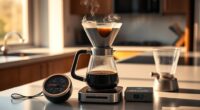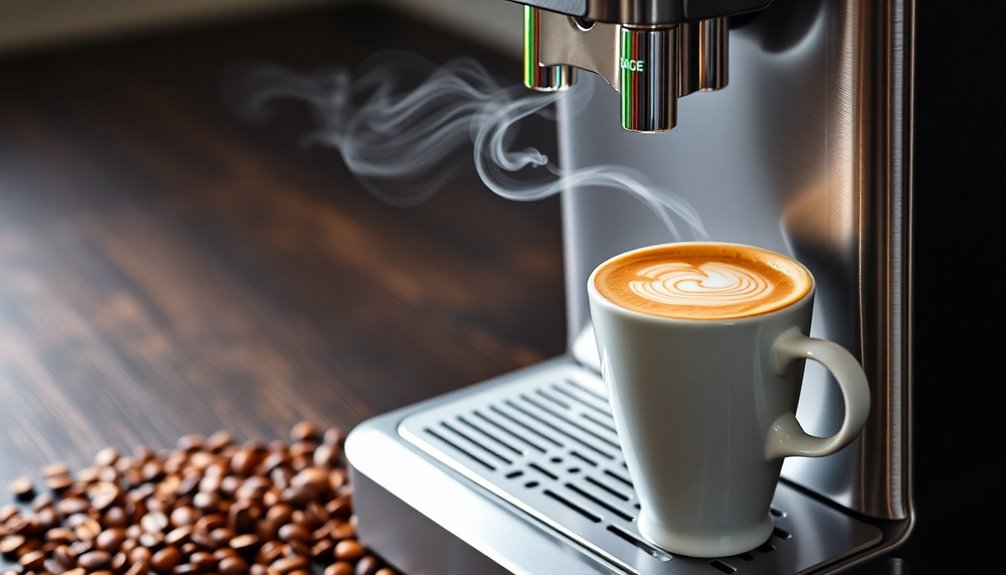To set yourself up for coffee brewing success, choose immersion if you prefer a simple, consistent, and smooth flavor by soaking grounds evenly for a few minutes. Opt for percolation if you want a stronger, more robust brew with hot water repeatedly passing through the grounds. Both methods have benefits and drawbacks, so consider your taste preference and lifestyle. Keep exploring to discover tips on mastering each technique for perfect coffee every time.
Key Takeaways
- Immersion offers a simple, consistent method ideal for beginners, while percolation provides a more robust, customizable brew.
- Use medium to coarse grind and accurate water temperature for optimal extraction in both methods.
- Immersion requires steeping for 4-5 minutes with gentle stirring; percolation involves cycling hot water through grounds repeatedly.
- Choose immersion for smoother, balanced flavors; select percolation for stronger, more intense coffee.
- Consider your equipment, time, and flavor preferences to set up for success in your first brewing experience.
Understanding the Basics of First-Time Immersion and Percolation
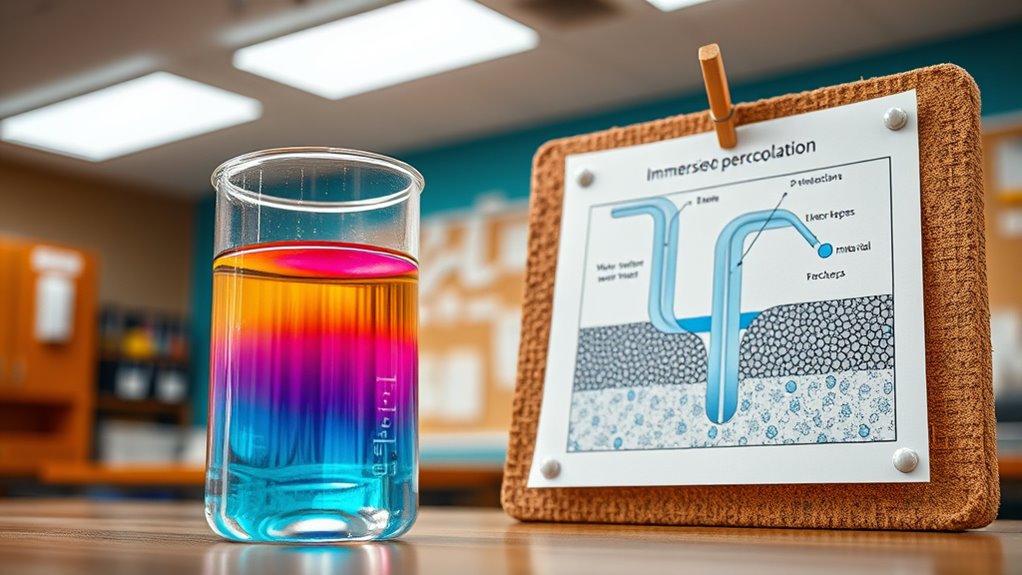
Have you ever wondered how coffee beans develop their flavor during brewing? The process starts with coffee bean selection, which influences the final taste. First-time immersion involves submerging coffee grounds in water for a set period, extracting flavors evenly. This method relies heavily on controlling brewing temperature to optimize extraction without overdoing it. Percolation, on the other hand, forces hot water through coffee grounds repeatedly, creating a stronger brew. Both methods emphasize the importance of brewing temperature for flavor development, but they differ in how they extract those flavors. With immersion, temperature affects the smoothness and balance, while in percolation, it influences strength and intensity. Understanding these basics helps you appreciate how each method emphasizes different aspects of coffee flavor. Additionally, brewing equipment plays a crucial role in achieving consistent results with either method.
Key Advantages and Drawbacks of Each Brewing Method

First-time immersion offers the advantage of simplicity and consistency, making it easy for beginners to brew a balanced cup without complicated equipment. You’ll enjoy reliable flavor consistency because the brewing process is straightforward, reducing variables that can affect taste. This method typically requires minimal equipment—just a container and a filter—keeping setup simple and affordable. However, immersion can sometimes result in over-extraction if you’re not careful, leading to a bitter or overly strong flavor. Additionally, it lacks the flexibility to adjust brew strength easily once the process starts. Compared to percolation, immersion is less complex and more forgiving, but it might not deliver the nuanced flavors that more intricate methods can achieve. It’s ideal for those seeking dependable results with minimal fuss.
Step-by-Step Guide to Preparing Coffee Using Immersion Technique

To prepare coffee using the immersion technique, start by measuring out your coffee grounds—generally one to two tablespoons per six ounces of water—and place them in your chosen container. Use a consistent coffee grind—medium to coarse—for ideal extraction. Fill the container with water at the ideal brewing temperature, around 195-205°F, ensuring the grounds are fully submerged. Let the mixture steep for 4 to 5 minutes, then gently stir to ensure even extraction. For a better flavor profile, consider the seasonal variations that can influence the taste of your brew. After steeping, use a filter or pour carefully to separate the grounds from the brewed coffee. Below is a quick overview:
| Step | Details |
|---|---|
| Measure coffee grounds | 1-2 tablespoons per 6 oz water |
| Add to container | Use your preferred vessel |
| Pour water | At 195-205°F, fully covering grounds |
| Steep | 4-5 minutes, stir midway |
| Filter and serve | Remove grounds, enjoy your coffee |
Step-by-Step Process for Percolation Coffee Preparation
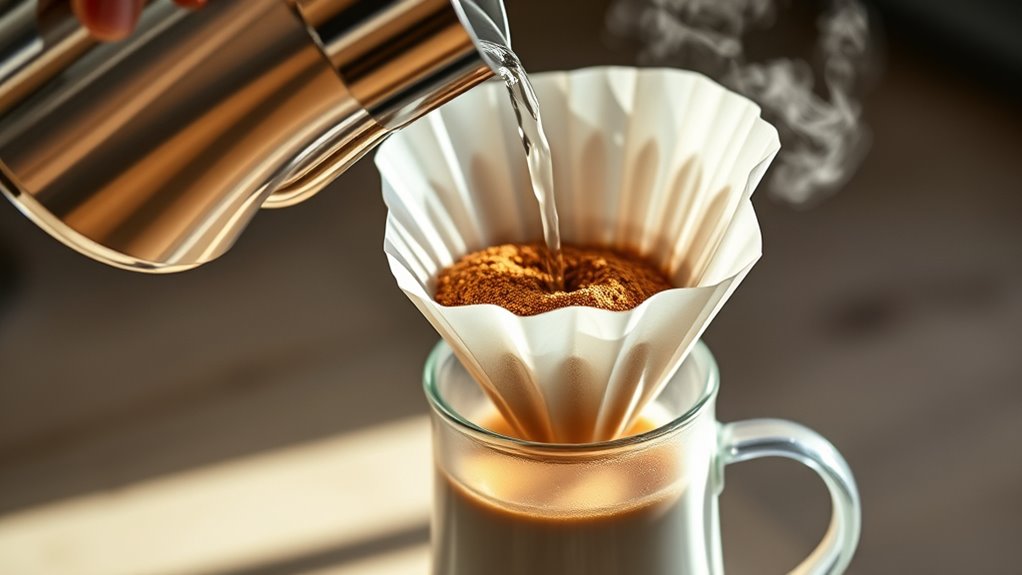
Percolation offers a different approach to brewing coffee, using a cyclical process that repeatedly passes hot water through the grounds to extract flavor. Begin by filling the percolator’s chamber with cold water, then add a measured amount of coffee grounds to the filter basket. Assemble the percolator securely, ensuring proper fit for brewing consistency. Turn on the heat and let the water cycle through the grounds, continuously extracting flavors. Keep an eye on the process, adjusting the brewing time to prevent over-extraction, which can lead to bitterness. Once the cycle completes, carefully remove the percolator from heat. Pour your coffee, and enjoy a robust brew with well-extracted flavors. This method emphasizes consistent brewing and thorough flavor extraction, resulting in a bold, satisfying cup.
Choosing the Right Method for Your Coffee Preferences and Lifestyle
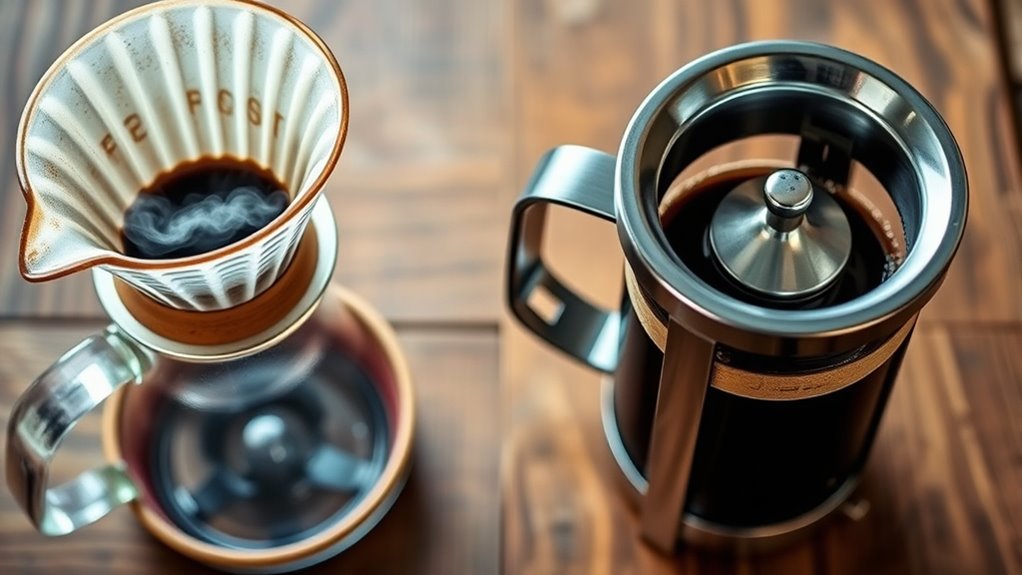
Choosing the right brewing method depends on your personal preferences and daily routine. If you crave flavor customization, immersion methods like French press give you control over steeping time and grind size, enhancing your coffee’s taste. Percolation, on the other hand, offers a consistent brew with less fuss, ideal for busy mornings. Consider how much effort you’re willing to put into equipment maintenance; immersion brewers often require regular cleaning to prevent flavor carryover, while percolators tend to be more straightforward. Think about your lifestyle—do you want a quick, hands-off process or a chance to fine-tune every cup? Matching your preferences with the right method ensures a satisfying coffee experience tailored to your routine. Additionally, understanding caffeine content can help you choose the brewing style that best aligns with your energy needs throughout the day.
Frequently Asked Questions
How Does Water Temperature Affect Immersion and Percolation Brewing?
Water temperature profoundly affects immersion and percolation brewing. When you use higher temperatures, water extracts flavors more efficiently, boosting brewing efficiency and producing a richer taste. Conversely, lower temperatures slow extraction, resulting in a lighter brew and potentially under-extracted flavors. For ideal results, you should aim for the right temperature based on your brewing method, typically around 195-205°F, to maximize brewing efficiency and achieve the desired flavor profile.
Can These Methods Be Adapted for Cold Brew or Iced Coffee?
Yes, you can adapt immersion and percolation methods for cold brew or iced coffee. For cold brew, use longer brewing durations to optimize flavor extraction without heat, typically 12-24 hours. For iced coffee, brew hot using these methods then chill. Adjust brewing duration based on desired strength and flavor, ensuring you extract enough coffee without overdoing it. Both methods deliver rich flavor while keeping the process flexible for cold or iced variations.
What Equipment Is Essential for Beginner Immersion or Percolation Brewing?
For beginner immersion or percolation brewing, you’ll need a good brew basket and filtration system. A sturdy brew basket ensures even extraction, while a reliable filtration system keeps grounds out of your coffee. Consider a simple pour-over dripper or French press for immersion, and a pour-over cone or percolator for percolation. These essentials make it easy to brew flavorful coffee and improve your brewing skills quickly.
How Do Grind Size and Coffee Freshness Influence Each Method’s Outcome?
Imagine your coffee as a symphony; grind size and freshness are the conductors. For immersion, a consistent grind guarantees even extraction, and fresh coffee yields vibrant flavors. Percolation benefits from slightly coarser, uniform grounds for clarity. Store coffee properly to preserve freshness, preventing staleness that dulls the brew. When you balance grind consistency and coffee storage, your method sings with rich, balanced flavors every time.
Are There Health Considerations Specific to Immersion or Percolation Brewing?
Health concerns differ slightly between immersion and percolation brewing. Immersion methods, like French press, can encourage microbial growth if you leave coffee sitting too long or don’t clean your equipment properly, posing potential health risks. Percolation brewing, such as drip machines, generally reduces this risk because the brewing process is quicker and involves hot water flowing through coffee, which helps minimize microbial growth. Always keep your equipment clean to stay safe.
Conclusion
Choosing between immersion and percolation is like selecting the right path for your coffee journey. While each has its subtle charms, finding what truly suits your taste and routine can gently lead you toward a more satisfying brew. Sometimes, a little exploration can reveal hidden delights, and other times, sticking with what feels most natural brings the best results. Trust your instincts, and let your coffee experience unfold beautifully—perhaps in ways you hadn’t initially expected.

